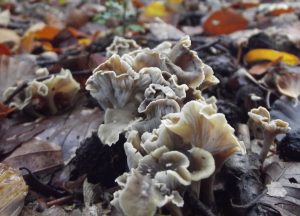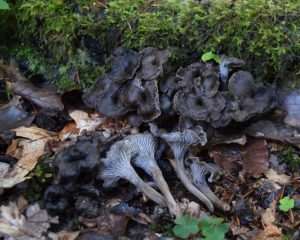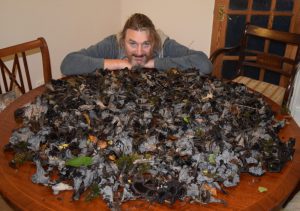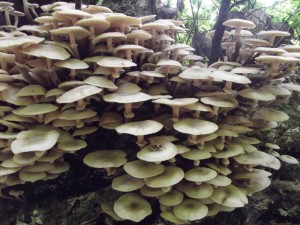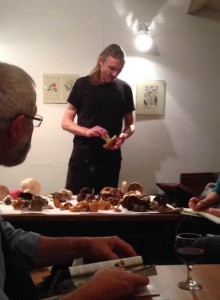Email: geoff@geoffdann.co.uk
10/09/2017
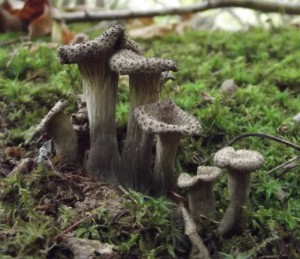
Horn of Plenty (Craterellus cornucopioides). October 2013. October is when you typically find this species in southern England.
Fungi foraging fanatics live for days like the one I just had. So many times you go out and find very little, or at least very little that you actually wanted to find. But by persisting, sooner or later you end up in exactly the right place at exactly the right time, and you find something spectacular – something rare and beautiful, something you’ve never found before or just the motherlode of one of your favourites. Last weekend it was the something I’d never found before, today it was the motherlode of my absolute number one favourite fungus. Today I not only saw more Horn of Plenty or Black Trumpets (Craterellus cornucopioides) than I have ever seen in a day before, I probably saw about as much as I have in my entire previous life before. Truly this fungus lived up to its name. I also learned something new about the way it grows and the way it spreads.
It wasn’t a great day for most other species. I was out with a private group and the only boletes we saw were a handful of Leccinums, the only Amanitas a few False Deathcaps, one or two Brittlegills, some Laccaria, along with a selection of very common inedible species like Wood Woollyfoot and Spotted Toughshank. Only the relatives of the Chanterelle were doing well, and not all of them were doing anything special. We saw a few Chanterelles (Cantharellus cibarius), but 2017 is not, so far, a classic year for members of the genus Cantharellus. Their more-distant relatives Hedgehog Fungi were also about in good numbers, but that’s true nearly every year. It’s only the Craterellus species that are going crazy.
Rewind to last week. When I got up last Saturday morning there were two British members of the genus Craterellus I’d never found in the 30+ years I’ve been hunting for fungi. (These are both better known under old Latin names, because they’ve recently been moved to Craterellus from Cantharellus. Recent evidence has suggested that all the hollow-stemmed members of this family should be Craterellus, not Cantharellus.) They are the Golden Chanterelle (Craterellus lutescens) and the Ashen Chanterelle (Craterellus cinereus), and I’d been searching for them without luck for so long that I wondered whether I might never find them. Anyway, last Saturday my wife and I were walking our labradoodle in a tract of woodland I have frequently visited over the past five years, and there were various sorts of Chanterelle all over the place. Significant quantities of Horn of Plenty in places I’d never previously seen them, Winter Chanterelles (Craterellus tubaeformis) just starting to fruit, at least a month earlier than they usually do, but most noticeable of all were quite a lot of Wavy-capped Chanterelles. These aren’t Craterellus – their Latin name is (currently) Pseudocraterellus undulatus – but they really ought to be. They share the same smooth spore-bearing surface and hollow stem of the Horn of Plenty and Golden Chanterelle, and are closely related. They are also supposed to be rather rare, but they aren’t this year. I have found large quantities of them over the last week, in many locations I’ve never seen them before. Then my wife found yet another patch of Black Trumpets – apparently in better condition than a lot of the others, which were well past their best. But as I turned them over, I immediately noticed they had false gills – gill-like wrinkles like those of a Winter Chanterelle. Black Trumpets don’t have false gills – they are smooth underneath. Much as they looked like them from above, these were no Black Trumpets.
They were Ashen Chanterelles, and it turned out that there were quite a few of them, although they are so rare that I only took a small amount for experimenting in the kitchen. It is not often I get the thrill of finding a wild fungus delicacy for the first time anymore, but one more was crossed off my dwindling to-find list that day. They turned out to be the most fragrant of any Chanterelle-relative I’ve eaten – intensely fruity, even more so than Black Trumpets. That day it became clear that 2017 is a classic Craterellus year, but only today has it become apparent to what extent, at least in some locations.
We were two-thirds of the way through today’s session, and we’d already filled a trug with Horn of Plenty and Hedgehogs. I decided to switch routes and headed off across a road to a different area, hoping to find something else. This was another very familiar tract of woodland, that I’ve observed carefully for the last few years. And I had seen some Horn of Plenty near the entrance to it before, and in a couple of locations in the interior. The most I’d seen in any one year was probably about enough to fill a couple of carrier bags – a decent “haul”, but not an explosion. Today there was a supernova. There were Horns of Plenty in every direction. They weren’t just growing in vast areas where I’ve never seen them before, but they were growing in dense clusters and some individual fruit bodies were enormous (for this species). I had not come equipped for foraging anything myself – the group had borrowed my trug and all I had was a small plastic carrier bag at the bottom of my rucksack. They also had a couple of bags. We spent nearly half an hour moving no more than 50 metres, collecting only the largest of the Black Trumpets, until we ran out of containers. Since running out containers pretty much ends a foraging session, we returned to our start point and the group disappeared off to Hastings planning a Horn of Plenty risotto – before a long evening of removing small creatures from their trumpets.
It had already been a very long weekend (I did another three-hour session yesterday), but my curiousity was such that I could not resist going back out in the woods one more time (my trug now returned, and my bag of trumpets emptied into a box in my car boot). I wanted to know what I would find at a location where, in previous years, there had been considerably more Horn of Plenty than where the group just hit the jackpot. It was only a ten minute walk.
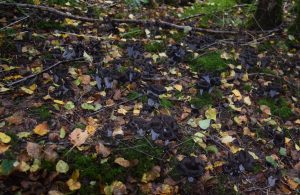
Horn of Plenty (Craterellus cornucopioides), today in Sussex. It was like this for 30 metres in every direction, and this was just one patch.
Oh. My. God.
This patch had also spread, and in the same relative direction, and the same relative extent. This wasn’t just an expanding mycelium, but hundreds of newly established mycelia, all fruiting like there is no tomorrow. I have never seen anything like it before, and that’s taking into account I’ve spent the last six years foraging full-time in the autumn, and I’ve seen mass-fruitings of this species before. There’s no way I could possibly have picked them all – I just grabbed handfuls of the largest specimens from each little patch, then moved on to the next. I don’t normally approve of “taking more than you need” or posting pictures of your “haul” but in this case these fruit bodies were unbelievably numerous, and a lot of them are at the point where if not picked, they would start to rot (and this is also a species not normally eaten by insect grubs, and largely left untouched by other wildlife (perhaps their strong odour is actually some sort of deterrent for other animals?). And this is one of the few species that is not only easily dried (it is thin-fleshed), but better dried than fresh, so easy to store in quantity without using freezer space. I too have a busy evening of cleaning and drying Black Trumpets; I have enough to last me until next Christmas.
What do I do with them? They go great in omelettes (a “tromplette”), with pasta, in a cream sauce with white fish, in casseroles and stews and quiches and have many other uses. But my absolute number one black trumpet dish is lamb shanks, slow cooked with mountains of black trumpets and penny buns. I am planning on getting round to posting the recipe some time soon, but tonight I have work to do!

